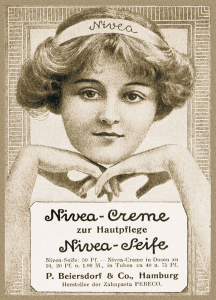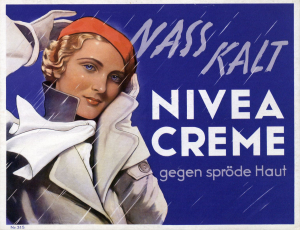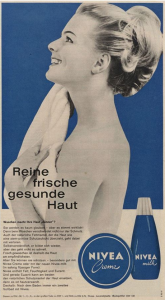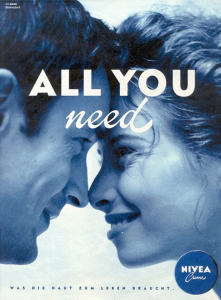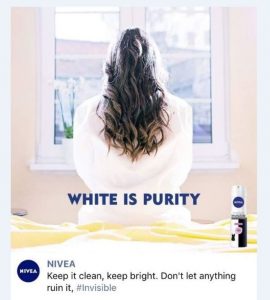
This advertisement was posted one of NIVEA’s Facebook pages on April 2nd of the previous year, and was sponsoring a new line of deodorant titled “Invisible: For Black and White.” According to the campaign, this is a new product that is specifically designed to prevent the discoloration of the customer’s clothes through excessive sweat, Although the ad was planned to have a full-print launch in the Middle East (with a focus on Iran), the plug was pulled only two days after the company posted this ad on Middle-East Facebook due to the severe backlash it received, primarily for its highly problematic tagline.
When regarding this ad, immediately the consumer’s eye is drawn to the thesis behind the product campaign: “White is Purity.” This kind of statement falls directly into Mary Douglass’ anthropological theory laid out in her magnum opus, Purity and Danger: an Analysis of Concepts of Pollution and Taboo. Essentially, the main implications of an association of whiteness with the conceptual notion of purity is twofold; which is to assert caucasian superiority on both an ethically abstract basis (e.g. to be morally pure and therefore inherently righteous) and a distinctive physical one (e.g. to not be tainted by dirt, or any any projected impurity). That is to say that the dichotomy consciously proposed by NIVEA serves not just to distinguish and separate blackness from whiteness, but to define whiteness itself by its lack of purity, thereby directly categorizing blackness not only as impure, but also as a direct threat to the purity of whiteness — or as they put it themselves, “…protection that keeps black clothes black and white clothes white for longer.”
Although the bolded, all-caps mantra that’s centralized in the advertisement is clearly emblematic of a severely prejudiced worldview, the bigoted implications don’t end there. The active distinction between white and black is also manifested in the literal lack of darkness in the advertisement: white clothes, white sheets, white window, off-white wall, bright yellow blanket, white sky, etc. Although the model’s skin is not directly revealed to her audience, the hairstyle she’s dressed up in evokes an identifiably anglo-saxon image, perfectly projecting her as the standard of whiteness and purity that NIVEA wants to sell. This Douglass-esque otherization and stigmatization of marginalized sub-cultural groups is almost perfectly and painfully evident in the caption posted to Facebook, introducing the ad, “Keep it clean, keep bright. Don’t let anything ruin it, #Invisible.” By using words like “clean,” “bright,” and “ruin”, and by introducing the officially undefined concept of “it,” NIVEA is stapling abstract standards of health and beauty onto a white-contained label, especially after fully establishing the threat and foreignness of blackness.
NIVEA rolled back the entire campaign within two days of sharing this advertisement, as it was immediately faced with not only a flood of low-level public criticism, but also massive big-name media attention as well (New York Times, The Washington Post, CNN, and many more). They released an official apology that reads as follows: “That image was inappropriate and not reflective of our values as a company. We deeply apologize for that and have removed the post. Diversity and inclusivity are crucial values of NIVEA. We take pride in creating products that promote beauty in all forms. Discrimination of any kind is simply not acceptable to us as a company, as employees, or as individuals.” They also diligently responded directly to individuals who called attention to their problematic rhetoric with similarly worded apologies.
Despite this myriad of socio-politically acceptable regret and carefully worded apologies, the disturbing underlying messages of the Invisible Deodorant ad were not lost on consumers. The advertisement was not only met with vehement disapproval from all popular media outlets and most online social presence, but was also avidly embraced by a small amount of far-right (or alt-right) activists. A relatively popular white supremacist group posted this statement on NIVEA’s Facebook page shortly after the ad was launched: “We enthusiastically support this new direction your company is taking. I’m glad we can all agree that #WhiteIsPurity.”
Although this advertising campaign is flagrant and offensive, it shouldn’t come across as shocking or unprecedented when contextualized in its cultural setting. Ultimately, as Douglass argues, these moments are ones that can (and should) be used to analyze a broad set of cultural implications, rather than giving into the temptation of only focusing on the isolated event itself. NIVEA’s Invisible Deodorant campaign is clearly a product of a cultural climate that is saturated with deeply prejudiced definitions of beauty and purity, to name only a few examples. Not only that, but the globalization of Western standards of attractiveness is a potent manifestation of the ethnocentric colonialist antics that have defined the culture’s evolution and warped its self-perception. Thus, even though the historically racist alt-right political party’s support for the ad campaign is deeply disturbing, it can be fully characterized as yet another exemplification of our culture’s prejudiced tendencies.
The fact that this product line was targeting a non-white and non-Western cultural climate is no coincidence; the globalization of our economic standards allows us to commodify and profit off of the beauty standards that we also project onto the communities we exploit. In essence, the fundamentally problematic implications of NIVEA’s recent advertising blunders are not indicative of a newly-spawned worldview. Their products and advertisements have always exhibited a clearly racist rhetoric, instead the change in reception that these ads have faced is a result of a cultural situation that’s evolving faster than NIVEA is.
